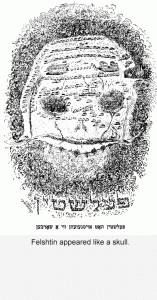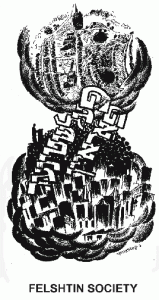By David G. Roskies
Yizkor, or memorial, is, of course, the central fact of the yizkor book, which pays tribute to the shtetl as a martyred community. The yizkor book was established early on, with Proskurov (1924) and, more importantly, Felshtin (1937). No one could have known what was to come. The Felshtin book became the model for many hundreds of yizkor books to follow after the Holocaust.

What do we see when we open the Felshtin zamlbukh? One striking image is a map of Felshtin in a torn scroll. Felshtin is part of a sacred scroll, a precious chronicle. A bayonet runs through the heart of the scroll, tearing it all apart. The caption is “the massacre.” This powerful image depicts the town as part of a scroll that has been desecrated, conveying a profound sense of defilement.
Another important image is the map of the town. Only a few places are identifiable: the main shul, the mill stream on one side. Remarkably, included are a Roman Catholic church on the top with its tall spires and an Eastern Orthodox church on the bottom, with its onion-shaped domes. This is accurate; there was not a shtetl that did not have at least two churches, but Jewish memory often omits mention of the churches.

In addition, there is a really bizarre picture of Felshtin in the shape of a skull. This must have been commissioned by Jonas Baum, who turned the map of the town upside down. The eyes are the lime pits that also doubled as garbage dumps.

The most important image is the same map of Felshtin in the clouds — a celestial shtetl coming to rest upon the skyline of Manhattan, its new promised land. The link between the shtetl that was and the city where we live is a meeting of the Felshtin Society, depicted by a man standing in front of a podium addressing the landsleit. Thanks to him, the link between the shtetl and the new home in America will be forged. It will be maintained not by raising memorials of stone or by building museums, but by people coming together to create an association where they tell the story of the town.
The Felshtin experience teaches us something very powerful. In the brief introduction to the yizkor book, Jonas Baum tells us that when the first news of the pogrom reached the American landsleit, they were filled with grief. What happened next? They could have thrown up their hands in despair and said, “The is the end; our town is no more. Everyone has been slaughtered, our parents and grandparents. There’s no point in going on with our lives. It’s all over.”
That’s not what happened. After the grief, relief efforts were organized. Then the victims were memorialized. American landsleit pooled their resources to put together the yizkor book. They faced enormous odds. They really didn’t know much about the shtetl. Yet willy nilly, they created a model for all the yizkor books to come.
The first section of the book recounted the history of the town, although nobody knew anything about its history before 1900. Traditional societies didn’t keep records. Often the people who prepared yizkor books had to hire a professional historian to write the opening chapter. The second section celebrated the flowering of the shtetl, usually between the two world wars. The shtetl enters the twentieth century, but modernity and tradition co-exist. In the case of Felshtin, historical memory begins around 1900 and goes only, of course, to 1919.
Next is mass martyrdom. It’s terrible to read these chapters. They tell it exactly as it was: who was killed by whom, when, where, how, without embellishment or metaphors; just the facts. The simplicity makes it so terrible. We have no defenses. The book concludes with the rebirth of the town in the new promised land, America or Israel. That’s the model established in the Felshtin book: obscure birth, flowering, mass martyrdom, and rebirth. The same story was repeated again and again.
The revitalization of the Felshtin Society is very important. The DNA of Jewish memory is not the family; it is the institution, the landsmanschaft. If we are to preserve the memory of Felshtin, we cannot do it as lone individuals. America is a very fragmented society; we live in a time of great mobility. The fact that we can get together and reconstitute ourselves as a community ensures that our story will live on for many generations to come.
This article was adapted from a talk presented to the Felshtin Society on February 7, 1999.
David G. Roskies is a Professor of Jewish Literature at the Jewish Theological Seminary of America, co-editor of Prooftexts: A Journal of Jewish Literary History and has authored several books, including The Shtetl Book, Against the Apocalypse, and The Literature of Destruction.
© Copyright 1999 by David Roskies. Permission to reprint must be obtained from the author.